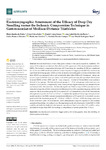Mostrar o rexistro simple do ítem
Electromyographic Assessment of the Efficacy of Deep Dry Needling versus the Ischemic Compression Technique in Gastrocnemius of Medium-Distance Triathletes
| dc.contributor.author | López-López, Daniel | |
| dc.contributor.author | Calvo-Lobo, César | |
| dc.contributor.author | Romero Morales, Carlos | |
| dc.contributor.author | San Antolín, Marta | |
| dc.contributor.author | Rodríguez-Sanz, David | |
| dc.contributor.author | Benito-de-Pedro, María | |
| dc.contributor.author | Benito-de-Pedro, Ana Isabel | |
| dc.date.accessioned | 2021-05-13T09:41:31Z | |
| dc.date.available | 2021-05-13T09:41:31Z | |
| dc.date.issued | 2021-04 | |
| dc.identifier.citation | Benito-de-Pedro, M.; Calvo-Lobo, C.; López-López, D.; Benito-de-Pedro, A.I.; Romero-Morales, C.; San-Antolín, M.; Vicente-Campos, D.; Rodríguez-Sanz, D. Electromyographic Assessment of the Efficacy of Deep Dry Needling versus the Ischemic Compression Technique in Gastrocnemius of Medium-Distance Triathletes. Sensors 2021, 21, 2906. https://doi.org/10.3390/s21092906 | es_ES |
| dc.identifier.issn | 1424-8220 | |
| dc.identifier.uri | http://hdl.handle.net/2183/27925 | |
| dc.description.abstract | [Abstract] Several studies have shown that gastrocnemius is frequently injured in triathletes. The causes of these injuries are similar to those that cause the appearance of the myofascial pain syndrome (MPS). The ischemic compression technique (ICT) and deep dry needling (DDN) are considered two of the main MPS treatment methods in latent myofascial trigger points (MTrPs). In this study superficial electromyographic (EMG) activity in lateral and medial gastrocnemius of triathletes with latent MTrPs was measured before and immediately after either DDN or ICT treatment. Taking into account superficial EMG activity of lateral and medial gastrocnemius, the immediate effectiveness in latent MTrPs of both DDN and ICT was compared. A total of 34 triathletes was randomly divided in two groups. The first and second groups (n = 17 in each group) underwent only one session of DDN and ICT, respectively. EMG measurement of gastrocnemius was assessed before and immediately after treatment. Statistically significant differences (p = 0.037) were shown for a reduction of superficial EMG measurements differences (%) of the experimental group (DDN) with respect to the intervention group (ICT) at a speed of 1 m/s immediately after both interventions, although not at speeds of 1.5 m/s or 2.5 m/s. A statistically significant linear regression prediction model was shown for EMG outcome measurement differences at V1 (speed of 1 m/s) which was only predicted for the treatment group (R2 = 0.129; β = 8.054; F = 4.734; p = 0.037) showing a reduction of this difference under DDN treatment. DDN administration requires experience and excellent anatomical knowledge. According to our findings immediately after treatment of latent MTrPs, DDN could be advisable for triathletes who train at a speed lower than 1 m/s, while ICT could be a more advisable technique than DDN for training or competitions at speeds greater than 1.5 m/s | es_ES |
| dc.language.iso | eng | es_ES |
| dc.publisher | MDPI | es_ES |
| dc.relation.uri | https://doi.org/10.3390/s21092906 | es_ES |
| dc.rights | Atribución 4.0 Internacional | es_ES |
| dc.rights.uri | https://creativecommons.org/licenses/by/4.0/ | * |
| dc.subject | Myofascial pain syndrome | es_ES |
| dc.subject | Trigger points | es_ES |
| dc.subject | Electromyography | es_ES |
| dc.subject | Deep dry needling | es_ES |
| dc.subject | Ischemic pressure technique | es_ES |
| dc.subject | Sindrome de dolor miofascial | es_ES |
| dc.subject | Puntos de activación | es_ES |
| dc.subject | Electromiografía | es_ES |
| dc.subject | Punción seca profunda | es_ES |
| dc.subject | Compresión isquémica | es_ES |
| dc.subject | Sindrome de dor miofascial | es_ES |
| dc.title | Electromyographic Assessment of the Efficacy of Deep Dry Needling versus the Ischemic Compression Technique in Gastrocnemius of Medium-Distance Triathletes | es_ES |
| dc.type | info:eu-repo/semantics/article | es_ES |
| dc.rights.access | info:eu-repo/semantics/openAccess | es_ES |
| UDC.journalTitle | Sensors | es_ES |
| UDC.volume | 21 | es_ES |
| UDC.issue | 9 | es_ES |
| UDC.startPage | 2906 | es_ES |
Ficheiros no ítem
Este ítem aparece na(s) seguinte(s) colección(s)
-
GI-UDISAP - Artigos [196]






